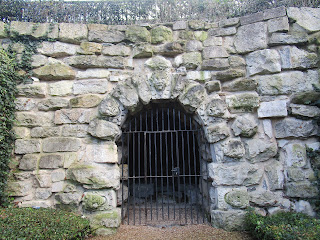This year I will carry on the approach of only posting here when there is something definitely worth posting about rather than as a discipline every other day, but although this isn't a church-related subject I nevertheless think it's a useful topic. It was only by accident that I very recently became aware of the follies of Ingress Abbey at Greenhithe in Kent, when someone on the Holy Wells LiberFaciorum page posted a picture of the Monk's Well. This was already mentioned in Ross Parish's book on Kentish wells, but I'd paid no attention to it and certainly not twigged that it formed part of a larger landscape of follies and garden design. So today I took the North Kent line out of London Bridge station and then the short walk to the park.
Ingress Abbey is an old estate going back to the 14th century, the current Tudor-Gothic house dating to 1833; between 1922 and the 19970s it was a nautical training college, but then fell into ruin. When the folly writers Headley & Meulenkamp came to the site, they found the park overgrown and the follies all but invisible, and worried about the whole place falling victim to redevelopment. This it did, but Crest Nicholson, who bought Ingress in 1998, restored the mansion and cleared out the grounds as well as building a sprawling new estate which strikes me as a sort of cut-price version of Poundbury in Dorset with its emphasis on the picturesque and individual. The current residents of the Abbey itself are British-Canadian oil and gas tycoon Sam Malin and his Cameroonian model and singer wife Irene Major: Mr Malin happens to be an Honorary Consul for Lithuania which is why the country's arms appear on the Abbey gates.
Following the Fastway road from the railway station, the first folly I came across was the Grotto, a set of shallow flint niches to the right of what was once the Abbey drive:
But this is just a very modest taster. Round the corner to the left in a close of modern dwellings, and down a flight of steps, is the very weird Cave of the Seven Heads. There are now only six of the eponymous Heads left, but very baleful they are indeed. The Cave itself has niches set into the flint interior.
We then follow the road round to the east, and take a flight of steps, which brings us to the gate of the Abbey and the way into the Park. Here we find the glorious ruined arch known as the Grange and its associated tunnel and ancillary chambers; the Monk's Well, which does actually have a well in it; and a decorated flint seat, the Lover's Arch, looking out over the lawn of the Park.
There are other structures around the Park which may have a more utilitarian origin - the blocked-up Georgian Tunnel, and what it variously called the Model Farm or the Limekiln:
Finally, to the east of the Park, in the middle of Palladian Circus, is a grass-covered mound topped by a flint needle capped with steel: you follow a spiral path to the top. This modern folly courtesy of the estate developers supposedly commemorates a Hermit's Cave which some say occupied the site (the mound was once taken to be Tudor, but it is not).
Along what remains of Greenhithe High Street is what seems to be a former chapel flanked by single-bay cottages, all in Gothic style and faced in flints. It might have nothing at all to do with the Abbey estate, but it seems worth mentioning too.















No comments:
Post a Comment